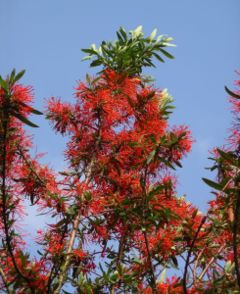Embothrium
| Embothrium {{{status}}} Fossil range: {{{fossil_range}}}
| ||||||||||||||||||||||||||||||||||||||||||||||||||||||||||||||||||
|---|---|---|---|---|---|---|---|---|---|---|---|---|---|---|---|---|---|---|---|---|---|---|---|---|---|---|---|---|---|---|---|---|---|---|---|---|---|---|---|---|---|---|---|---|---|---|---|---|---|---|---|---|---|---|---|---|---|---|---|---|---|---|---|---|---|---|
 Embothrium coccineum tree in flower, Wales | ||||||||||||||||||||||||||||||||||||||||||||||||||||||||||||||||||
| Plant Info | ||||||||||||||||||||||||||||||||||||||||||||||||||||||||||||||||||
| ||||||||||||||||||||||||||||||||||||||||||||||||||||||||||||||||||
| Scientific classification | ||||||||||||||||||||||||||||||||||||||||||||||||||||||||||||||||||
| ||||||||||||||||||||||||||||||||||||||||||||||||||||||||||||||||||
| [[{{{diversity_link}}}|Diversity]] | ||||||||||||||||||||||||||||||||||||||||||||||||||||||||||||||||||
| {{{diversity}}} | ||||||||||||||||||||||||||||||||||||||||||||||||||||||||||||||||||
| Binomial name | ||||||||||||||||||||||||||||||||||||||||||||||||||||||||||||||||||
| {{{binomial}}} | ||||||||||||||||||||||||||||||||||||||||||||||||||||||||||||||||||
| Trinomial name | ||||||||||||||||||||||||||||||||||||||||||||||||||||||||||||||||||
| {{{trinomial}}} | ||||||||||||||||||||||||||||||||||||||||||||||||||||||||||||||||||
| Type Species | ||||||||||||||||||||||||||||||||||||||||||||||||||||||||||||||||||
| {{{type_species}}} | ||||||||||||||||||||||||||||||||||||||||||||||||||||||||||||||||||
| Species | ||||||||||||||||||||||||||||||||||||||||||||||||||||||||||||||||||
| See text | ||||||||||||||||||||||||||||||||||||||||||||||||||||||||||||||||||
| [[Image:{{{range_map}}}|{{{range_map_width}}}|]] | ||||||||||||||||||||||||||||||||||||||||||||||||||||||||||||||||||
| Synonyms | ||||||||||||||||||||||||||||||||||||||||||||||||||||||||||||||||||
| {{{synonyms}}} |
Embothrium is a genus of two to eight species (depending on taxonomic interpretation) in the plant family Proteaceae, native to southern South America, in Chile and adjacent western Argentina and southern Peru; the genus occurs as far south as Tierra del Fuego. Common names include Chilean Firebush in English, and Notro, Ciruelillo, Fosforito in Chilean Spanish.
They are large shrubs or trees growing to 10-20 m tall with a trunk up to 70 cm diameter. The leaves are evergreen, occasionally deciduous in cold areas, 5-12 cm long and 2-4 cm broad. The flowers are produced in dense bunches, brilliant red (rarely white or yellow), tubular, 2.5-4.5 cm long, split into four lobes near the apex which reflex to expose the stamens and style.
- Species
- Embothrium coccineum J. R. Forst. & G. Forst. Chile, Argentina.
- Embothrium grandiflorum Lam. Peru, at high altitudes in the Andes.
- Embothrium lanceolatum Ruiz & Pav. (syn. E. coccineum var. lanceolatum (Ruiz & Pav.) O.Kuntze). Chile, Argentina; doubtfully distinct from E. coccineum.
Classification
Together with Telopea, Oreocallis and Alloxylon, Embothrium makes up a small group of terminal often red-flowering showy plants scattered around the southern edges of the Pacific Rim. Known as the Embothriinae, this is an ancient group with roots in the mid Cretaceous, when Australia, Antarctica and South America were linked by land.
Cultivation and uses
Embothrium coccineum is grown as an ornamental plant for its vivid red flowers. It is only successful in oceanic climates, which away from its native area includes western Europe (mainly the British Isles and the Faroe Islands), the coast of the Pacific Northwest of North America, and New Zealand.
External links
-
Embothrium Bark
-
Embothrium leaves
-
Embothrium coccineum, taken nearby Lakutaia Hotel at Navarino Island, by the Beagle Channel
-
Embothrium flowers


